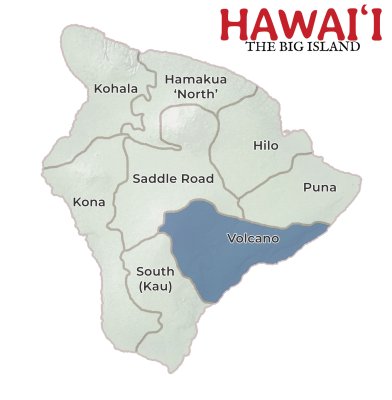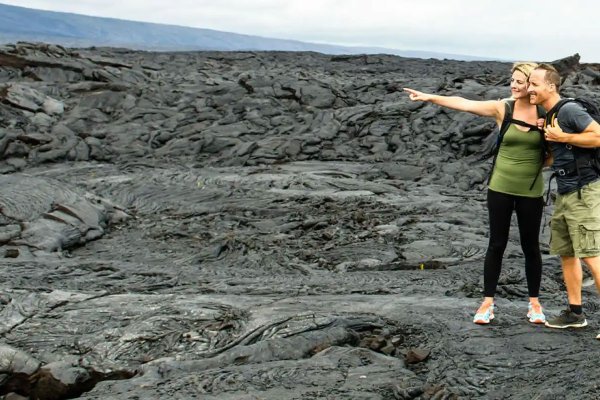01-03-2025
John C. DerrickVolcano Region
Kilauea, HVNP, etc
This article may contain affiliate links. We earn a small commission at no extra cost to you. Mahalo!
Volcano Region Sights, Tours, & Information
Things to Do & Visitor Tips for Volcano on Big Island Hawaii
If there's one single hot-spot on the island (no pun intended) for visitors then it's definitely the Volcano area. The area, is of course, most famous for Hawai'i Volcanoes National Park (HVNP).

Kilauea has made quite a name for itself since it began erupting in January 1983, and it has taken on the title as the world's most active volcano. It's re-written the books on how geologists look at the volcano's entirely. A lot of folks hear the world volcano and immediately visualize the Hollywood images of mass destruction, pyroclastic flows, lava quickly consuming everything down a steep slope, etc.
OK, let's put an end to that mentality before we even start. Kilauea is the exact opposite of everything you've grown to expect from a volcano, in fact, you can't even really see the mountain at all. For a long time even, geologists assumed Kilauea was a side vent of Mauna Loa, but today we know otherwise. Kilauea is definitely a separate volcano with its own magma chamber, it acts independent of any other volcano on the island. As described in the geology portion of this website, Kilauea is a shield volcano, meaning it erupts very slowly and on a very gradual plane.
There are no real explosive eruptions at Kilauea, nothing even close to what you'd see from a volcano on the west coast of the US (composite volcanoes). In fact, there are only two verified explosive eruptions in all of Kilauea's extensive history. Lava flows here typically move one of two speeds, slow, and really slow. Kilauea currently, as of this writing, is erupting within its main summit caldera, named Halemaumau crater. Kilauea may be a gentle giant compared to its explosive cousins, but this volcano has done its fair share of damage in the not so distant past. It was just in 1990 Kilauea completely destroyed the town of Kalapana and the nearby Royal Gardens subdivision. In 2018, additional towns and landmarks along the eastern coast were also destroyed in an eruption event.
The most commonly asked question is always... "Will I get to see lava?" You might and you might not, it's really just the luck of the draw. Most of the lava traverses from Kilauea into the ocean via underground lava tubes (see Nahuku Thurston Lava tube for a look into an ancient tube). When surface flows do break out, you can usually get pretty close to them, safety permitting. Lava flows can be near the end of Chain of Craters road or several miles out. Usually, you can always view lava entering the ocean from a distance, but even this is no guarantee as access can be limited due to the danger associated with lava bench collapses. We still believe one of the best ways to see Kilauea is from above, more on that later.
We honestly believe one of the biggest mistakes visitors make is that they do not devote enough time to the HVNP area. We highly encourage you to allow at least two whole days to this area, preferably starting from Hilo or another nearby town (like Volcano) each day. The drive from Kailua-Kona can be especially long. So plan ahead and make sure you give yourself enough time to view this remarkable area.
Volcano Region Top 5 Things to Do
Best Things to See & Do in the Volcano Region
Kipuka Puaulu 'Bird Park'
#5 Rated in Volcano Region on the Big Island
A kipuka is an area of land which was once lava but has been surrounded on all sides by more recent flows. If left undisturbed for a long time, an ecosystem, such as that a Kipuka Puaulu, forms.
Puaulu also called 'Bird Park,' is an old ohia tree and fern forest which is home to many of the feathered residents of the Big Island. A 30-minute stroll along this 1-mile trail will reveal several different high elevation birds, including the colorful Khalij Pheasant.
A restroom and picnic tables with barbecue pits are near the trailhead.
Crater Rim Drive
#4 Rated in Volcano Region on the Big Island
Crater Rim Drive is an 11-mile road that skirts the edge of the Kilauea Caldera in Hawaii Volcanoes National Park and contains several scenic views and hiking opportunities**. If you had to choose only one thing to do in HVNP (may that never occur!), this drive would be it.
Unfortunately, at this time, several attractions along Crater Rim Drive remain closed due to the most recent volcanic events & activity that occurred in 2018. But don't let the partial closures deter you, there are still plenty of great things to see on Crater Rim Drive.
We advise visitors to check with the ranger station for details about closures during their visit.
Chain of Craters Road
#3 Rated in Volcano Region on the Big Island
Chain of Craters Road may be one of the unique experiences you have on the Big Island.
Stretching 18 miles and going from 4,000 ft. elevation to sea level, this scenic drive along the East Rift Zone of the volcano in HVNP is pockmarked with craters of varying shapes and sizes, lava flows, petroglyphs, and, possibly, active lava.
Along this road, you will also find many interesting hikes, breathtaking vistas, and the opportunity to see what 'Madame Pele' (Hawaiian volcano & fire goddess) does best when erupting.
Kilauea Iki Trail
#2 Rated in Volcano Region on the Big Island
As you stand at the Kilauea Iki overlook you can see a lightly-etched trail stretching across the crater floor. From your 400 ft high vantage point you might be able to see little specks walking the path: those are people!
Kilauea Iki is an approximately four-mile loop that takes 2-3 hours. It skirts the rim of the crater, dips down and across the floor and back up to the overlook. The portion of Crater Rim Trail that runs along the rim is a dense high-elevation jungle populated with flowering ohia trees and graceful ferns.
Hawaii Volcanoes National Park
#1 Rated in Volcano Region on the Big Island
Originally founded in 1916, Hawaii Volcanoes National Park (HVNP) is a living, breathing testament to the awesome power of Mother Nature. HVNP is located 30 miles southwest of Hilo and 96 miles southeast of Kona. It's open year-round, 24 hours a day.
HVNP is home to Kilauea Volcano, the most continuously active volcano in the world, and the park offers the unique experience of walking on land that is younger than you are. In recognition of its outstanding natural values, Hawai'i Volcanoes National Park has been honored as an International Biosphere Reserve and a World Heritage Site.
The park encompasses 333,000 acres of natural wonders and is situated at 4,000 feet above sea level. With its wealth of trails, drives, and activities you will likely need at least two days to fully experience all the park has to offer.
All Volcano Region Attractions
Categorized by Type

Volcano Region Sights
Top Volcano Region Sights
Visit Hawaii Volcanoes National Park, watch the landscape change before your eyes, and walk on ground younger than you are! Here you'll find Kilauea, one of the world's most active volcanoes and the force behind so many unbelievable sights. However, don't think everything is barren here- stop by the Kilauea Visitor Center and the Jaggar Museum to learn all about the fascinating forces at work.
- Hawaii Volcanoes National Park - #1 Best in Sights on the Big Island
- Chain of Craters Road - A Must See inside HVNP!
- Crater Rim Drive - A Must See inside HVNP!
- Kilauea Caldera Overlook
- Tree Molds
- Kilauea Iki Overlook
- Nahuku Thurston Lava Tube
- Kipuka Puaulu Bird Park

Volcano Hikes
Top Volcano Hikes
- Kilauea Iki Trail - #1 Best Hike on the Big Island
- Tree Molds
- Kipuka Puaulu 'Bird Park' Trail - #10 Best Hike on the Big Island
- NahukuThurston Lava Tube
- Napau Crater Trail - #9 Best Hike on the Big Island
Volcano Area Travel Tips
Information for Visitors to the Big Island Volcano Region
Affiliate Disclosure: We may earn commissions from some travel partners (like Amazon or Expedia) which helps us maintain this site. These links are at no extra cost to you and don't impact our honest & unbiased recommendations. Remove all the ads →




